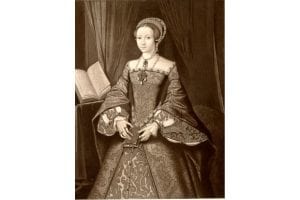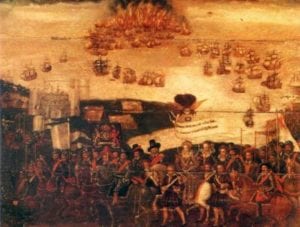(Queen Elizabeth I) The daughter of King Henry VIII and his second wife, Queen Anne Boleyn, she was born in Greenwich Palace, London, on 7 Sept 1533. Famously unwanted, because her tyrannical father was obsessed with having a son to succeed him, Elizabeth’s early life was troubled. When she was only two and a half years old her mother was beheaded and Elizabeth spent the rest of her childhood in the shadow of her father’s court. No one imagined then that she would grow up to become one of the most successful and famous rulers of all time who brought almost half a century of stability after the turmoil of her siblings’ short reigns. A devout protestant Christian, she was known as The Virgin Queen because she never married or had children, and was the last Tudor monarch. Her finest hour came in 1588 when she defeated the Spanish Armada, catapulting her to legendary status. When she died in 1603, deeply mourned by her people who called her Good Queen Bess or Gloriana, a new dynasty came to the throne, the Stuarts.

By the time of Henry VIII’s death, Elizabeth was third in line to the throne behind her younger brother Edward and elder sister Mary. It is one of the greatest ironies of history that Henry VIII had been so obsessed with having a son, yet his cherished boy only reigned for six years, dying of tuberculosis at the age of just 15. The second in line, Mary, did not fare much better. Her brief, catastrophic reign ended after just five years. It was up to Elizabeth to show them how it ought to be done and she didn’t disappoint.
Elizabeth came to the throne in November 1558, at the age of 25, having survived imprisonment in The Tower of London during the reign of her half-sister, Queen Mary I. Elizabeth was 25 years of age and ruled England for almost 45 years. Her reign is known as The Golden Age, a time that saw the birth of Shakespeare, the defeat of the Spanish Armada, and the emergence of England as a world power. Flame-haired, white-faced and always lavishly dressed, Elizabeth possessed the natural charisma of her father, Henry VIII, and was the darling of her people.
Best-selling author and historian Dr Tracy Borman explains what the the accession of Elizabeth I has meant for women in positions of power.
When Elizabeth I became queen upon the death of her half-sister ‘Bloody’ Mary on 17 November 1558, there was great rejoicing across the kingdom. Church bells were rung and bonfires were lit, and thousands of people gathered to drink and make merry.
Beneath the euphoria, however, lay the deep-seated prejudice against female rulers that had existed for centuries. The vast majority of Elizabeth’s new subjects believed that women were naturally inferior to men in every respect. They had neither the intelligence nor the strength of character to make their own way in the world. Even Elizabeth’s closest adviser, William Cecil, was furious when one of the Queen’s messengers discussed with her a dispatch for her ambassador in Paris, exclaiming that it was ‘too much for a woman’s knowledge.’
Whereas Mary had confirmed such prejudices during her brief, disastrous reign, Elizabeth set out to confound them. Although she shared her male subjects’ views on the inferiority of women, she saw herself as an exception and was determined to stamp her authority upon all aspects of her court and government.
She started by refusing to marry – a deeply shocking concept in an age when it was universally accepted that a woman (let alone a queen) could not make her way in the world without the guidance of a husband. But Elizabeth was adamant: ‘I will have but one mistress here, and no master’, she told her courtiers. Although she encountered fierce resistance to this at first, over time her single state became one of the cornerstones of her success: it secured her place as the Virgin Queen of legend.
Another part of Elizabeth’s strategy to win over her misogynistic new subjects was to refer to herself time and again in masculine terms. She was a ‘prince’ who led her people with just as much authority as her formidable father, Henry VIII.
But she also knew exactly when to flaunt her femininity. She created a court based upon the principles of chivalric love, with herself at the centre – at turns delighting, frustrating and enslaving the male courtiers who flocked to pay her homage.
She would also use her womanly ‘weaknesses’ as an excuse not to take action. When under intense pressure to sign the death warrant of Mary, Queen of Scots, she told a parliamentary delegation that ‘my sex doth not permit it.’
On ElizabethI.org you can read about Queen Elizabeth I’s remarkable life, her struggles and triumphs, the world in which she lived, her palaces, royal court, courtiers and statesmen, her rivalry with Mary, Queen of Scots, her effort to re-establish the Protestant Church of England, her portraits, food, clothes, pastimes, and all the people and events that make this one of the most fascinating and important eras of history.
This is the speech the queen gave to her troops in 1588 when the Spanish Armada was approaching the shores of England.
Here’s the actual speech to which the movie stayed quite close:
“My loving people, We have been persuaded by some that are careful of our safety, to take heed how we commit our selves to armed multitudes, for fear of treachery; but I assure you I do not desire to live to distrust my faithful and loving people. Let tyrants fear. I have always so behaved myself that, under God, I have placed my chiefest strength and safeguard in the loyal hearts and good-will of my subjects; and therefore I am come amongst you, as you see, at this time, not for my recreation and disport, but being resolved, in the midst and heat of the battle, to live and die amongst you all; to lay down for my God, and for my kingdom, and my people, my honour and my blood even, in the dust.
I know I have the body but of a weak and feeble woman; but I have the heart and stomach of a king, and of a king of England too, and think foul scorn that Parma or Spain, or any prince of Europe, should dare to invade the borders of my realm; to which rather than any dishonour shall grow by me, I myself will take up arms, I myself will be your general, judge, and rewarder of every one of your virtues in the field. I know already, for your forwardness you have deserved rewards and crowns; and We do assure you in the word of a prince, they shall be duly paid you. In the mean time, my lieutenant general shall be in my stead, than whom never prince commanded a more noble or worthy subject; not doubting but by your obedience to my general, by your concord in the camp, and your valour in the field, we shall shortly have a famous victory over those enemies of my God, of my kingdom, and of my people.”
“Bloody Mary,” daughter of Henry VIII, reigned five years, during which time her government sentenced 300 people to death. On Oct. 16, 1555, facing their execution, Bishop Hugh Latimer exhorted Nicholas Ridley: “Play the man, Master Ridley. We shall this day light such a candle, by God’s grace, in England, as I trust shall never be put out.” When Mary died, Nov. 17, 1558, her half-sister Elizabeth became Queen. Elizabeth, the daughter of Henry VIII and Anne Boleyn, replied at her Coronation in 1558, when questioned as to the presence of Christ in the Sacrament:
Christ was the Word that spake it,
He took the bread and brake it,
And what that Word did make it,
I do believe and take it.
Elizabeth stated: “There is only one Christ, Jesus, one faith. All else is a dispute over trifles.”
Elizabeth continued the Church of England begun when her father, Henry VIII, separated from Rome. “Puritans” wanted to purify the Anglican Church, wanting it to be even further from Rome. Another group gave up trying to purify the Anglican Church and decided to separate themselves – being called “Separatists” or “Pilgrims.” They eventually fled to Holland, and then later to America.
During the 45 year reign of Queen Elizabeth I:
- Shakespeare wrote plays
- Francis Bacon began the scientific revolution
- Sir Walter Raleigh began a colony he named Virginia, in honor of the “Virgin Queen Elizabeth”
Elizabeth told William Lambarde in 1601: “He that will forget God, will also forget his benefactors.”
Virginia’s Charter, 1584, stated: “Elizabeth, by the Grace of God of England … Defender of the Faith … grant to our trusty and well beloved servant Walter Raleigh … to discover … barbarous lands … not actually possessed of any Christian Prince, nor inhabited by Christian People. …”
Virginia’s Charter continued: “Upon … finding … such remote lands … it shall be necessary for the safety of all men … to live together in Christian peace. … Ordinances … agreeable to … the laws … of England, and also so as they be not against the true Christian faith.”
In 1585, Sir Walter Raleigh established a settlement at Roanoke Island, in present-day North Carolina, but it had to be ignored for three years due to Spain’s impending invasion of England. The colony was mysteriously abandoned, being referred to as “The Lost Colony.”
Spain had defeated the Ottoman Muslim fleet at the Battle of Lepanto in 1571, but rather than free the rest of the Mediterranean from Muslim control, Spain turned its attention to squelching the Reformation in Holland and England.
Beginning in 1572, Spanish General Alba, known as the Iron Duke, committed the “Spanish Furies,” pillaging, burning, raping and slaughtering in Holland. This led to the 80 years war and eventually Holland’s independence.
In 1588, the Invincible Spanish Armada sailed to invade England. The Armada consisted of 130 ships, 1,000 iron guns, 1,500 brass guns, 7,000 sailors, 18,000 soldiers, plus 30,000 soldiers from the Spanish Netherlands.
Queen Elizabeth told her troops, Aug. 19, 1588: “Let tyrants fear. … I know I have the body but of a weak and feeble woman; but I have the heart and stomach of a king, and of a king of England too, and think foul scorn that … Spain, or any prince of Europe, should dare to invade the borders of my realm. … I myself will take up arms, I myself will be your general. … Your valour … shall shortly have a famous victory over those enemies of my God, of my kingdom, and of my people.”
England’s smaller, more maneuverable vessels proved difficult for the Spanish to apprehend. Then, at midnight, July 28, 1588, Sir Francis Drake set eight English ships on fire and floated them downwind to the closely anchored Spanish ships. In a panic, the Spanish ships cut anchor. An unusual violent hurricane scattered and destroyed most of the Spanish Armada.
When King Philip II of Spain learned of the loss, he exclaimed: “I sent the Armada against men, not God’s winds and waves.”
With its Armada destroyed, Spain’s monopoly of the seas ended. England was established as a major European power, and Holland, Sweden and France joined in founding colonies in America.
Adam Smith wrote in “The Wealth of Nations,” 1776: “The Spaniards, by virtue of the first discovery, claimed all America as their own, and … such was … the terror of their name, that the greater part of the other nations of Europe were afraid to establish themselves in any other part of that great continent. … But … the defeat … of their Invincible Armada … put it out of their power to obstruct any longer the settlements of the other European nations. In the course of the 17th century … English, French, Dutch, Danes, and Swedes … attempted to make some settlements in the new world.”
Queen Elizabeth, the last Tudor monarch, stated in 1566: “I am your Queen. I will never be by violence constrained to do anything. I thank God I am endued with such qualities that if I were turned out of the Realm in my petticoat I were able to live in any place in Christendom.”
Queen Elizabeth told the House of Commons in the “Golden Speech,” Nov. 30, 1601: “Though God hath raised me high, yet this I count the glory of my Crown, that I have reigned with your loves. … I do not so much rejoice that God hath made me to be a Queen, as to be a Queen over so thankful a people. … The title of a King is a glorious title, but … we well know … that we also are to yield an account of our actions before the Great Judge.”
In France, the tolerant “Good King” Henry IV had at least a dozen assassination attempts on his life before he was eventually assassinated in 1610. When rumors arose in England of a possible plot to assassinate her, Elizabeth executed dozens, including, sadly, her cousin, Mary Queen of Scots, who was under her protection. Mary Queen of Scots was the mother of James VI, who became England’s next monarch, King James I, noted among other things for the Jamestown Colony and the King James Bible.
Responding to questions from Parliament regarding succession after her death, Elizabeth stated: “I know I am but mortal and so therewhilst prepare myself for death, whensoever it shall please God to send it.”
Elizabeth died March 24, 1603. Of her epitaph, Queen Elizabeth I said: “I am no lover of pompous title, but only desire that my name may be recorded in a line or two, which shall express my name, my virginity, the years of my reign, and the reformation of religion under it.”
Conspiracy of Queen Elizabeth
Queen Elizabeth I, who ruled England for 44 years between 1558 and 1603, defeated the Spanish Armada, rejoined what had been a divided country, and encouraged the arts to flourish. What she didn’t do was marry. The Queen refused any and all advances to enter matrimony, a policy that led to her nickname of the Virgin Queen. Her stance led some observers—including Dracula author Bram Stoker—to suspect she may have been a man.
Stoker once visited the town of Bisley in the Cotswolds, where a May Day celebration involved a boy dressing as the May Queen in Elizabethan clothes. Intrigued by the ceremony, Stoker discovered a fantastic tale—that the queen-to-be had visited Bisley in her youth to escape the plague, got sick, and died. Knowing her father, King Henry VIII, had a famous temper, the governess found a boy who resembled her charge and disguised him as Elizabeth when the king, who apparently could not readily identify his own daughter, came to visit. The deception was never discovered, and the unknown boy grew to rule England, disguising his masculine features with wigs, heavy make-up, and neck coverings. While Stoker popularized the story in the early 1900s, it had appeared during Elizabeth’s reign, possibly as a way for male subjects to cope with the idea of having a female ruler.
Sources:
- https://www.wnd.com/2018/11/queen-elizabeth-i-important-to-american-history/#hkD4AdXQZ74xoUcJ.99
- http://www.elizabethi.org/
- http://blog.english-heritage.org.uk/why-was-queen-elizabeth-i-so-important/
Chronological History of Events Involving Queen Elizabeth I




